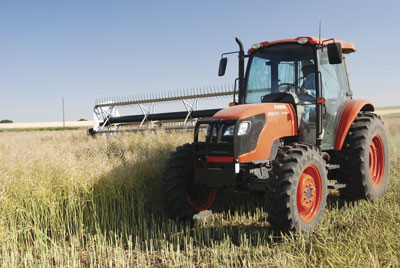
Features
Agronomy
Cereals
Canola variety selection helps spread risk
If ever there were a growing season that required flexibility, the 2009 edition was it. With a cold late spring, a June frost and a crop that was two to three weeks behind normal in many parts of the Prairies, selecting several canola varieties to spread the risk was a good strategy.
October 20, 2009 By Top Crop Manager
If ever there were a growing season that required flexibility, the 2009 edition was it. With a cold late spring, a June frost and a crop that was two to three weeks behind normal in many parts of the Prairies, selecting several canola varieties to spread the risk was a good strategy. “The way we plan it, we try to seed the earliest maturing first, and if there is a two or three day difference, hopefully we notice it, and if the year is right, it might even be four to five days different,” explains Ryan Nevin, who farms north of Brandon, Manitoba, in a long-season zone.
 |
|
| Staggering maturity dates helps plan swathing. Photo by Bruce Barker. |
In 2009, Nevin tried 43E01, a new Roundup Ready Pioneer Hi-Bred variety with early maturity and good yield potential. In Prairie Canola Variety Trials (PCVT), 43E01 averaged four days earlier than the check variety 45H21. He had a promising crop until an early June frost cut it down and forced him to reseed. Still, his past experience shows that he was on the right track to spread his maturities to help with harvesting, and to allow an early crop to be taken off so he could seed the land back to winter wheat.
In 2008, Nevin’s earliest variety was 45H26, and he also grew the Cargill specialty oil variety 1035 that was about two to three weeks later, partly due to seeding one week later, but also because of very slow maturity; about five to six days longer than the performance trails indicated. “The later maturity wasn’t an issue, but it did add to opening the harvest window. Last year in 2008, it worked out well. We had a maximum of 200 to 300 acres ready at a time. We were able to do it, and then move on to the next field,” explains Nevin, who crops 3700 acres and typically has 1000 acres of canola. “It really took the pressure off swathing last year, and allowed us to get our winter wheat in.”
At the other end of the Prairies, Derek Dreger of Grande Prairie, Alberta chooses his canola varieties based on a slightly different strategy. Farming in the short season zone of the Peace River region, Dreger picks canola varieties based on herbicide system and then maturity. With 4200 acres of wheat, barley, oats, canola and fescue, he grows Liberty Link canola on fields that were in fescue because he gets good in-crop control of volunteer fescue with Liberty herbicide. He grows Roundup Ready canola on his dirtiest land.
“Depending on the field, I pick different varieties that flower at different times. Sometimes earlier flowering crops beat the heat and have better yield, and sometimes the later ones do better. It all depends on when we get the heat,” explains Dreger.
Dreger typically sows his wheat and barley first, while his canola is the last crop to go in. He has found that seeding canola later results in faster germination and more-uniform plant stands because the soil is warmer, but that puts pressure on canola maturity. He has grown mid-season 45H24, 45H26, and 45H28 Roundup Ready canola varieties on his cereal stubble, and three different InVigor varieties on the fescue land. Dreger also knows which pieces of land produce later-maturing crops, and selects earlier-maturing varieties for those fields.
Nevin also employs some of those same strategies. He seeds peas and wheat first, followed by canola and flax. Occasionally, if the spring is warm, he will split up the wheat and seed some canola. He also grows both Roundup Ready and InVigor varieties to try to balance the yield potential with maturity to help manage the harvest work load. He has tried straight combining, but to date, it has not worked out to his advantage.
Growers must assess maturity on their own farms
While the PCVT information is a good starting point, Jay Patel, a Pioneer Hi-Bred canola breeder says that local conditions make a difference. The PCVT summarizes small plot data across the Prairies, segmenting them into short-, mid- and long-season zones. He explains that there could be a three to four day difference in maturity on average, but in some years the variety could be seven days earlier in the Peace River regions and only two days earlier in southern Manitoba. “You will see some differences under two conditions. With cooler conditions, you can see the spread to be bigger. Also, as you go further north, the difference becomes bigger as well,” explains Patel.
Part of the reason short season areas in the north may have a greater maturity spread between varieties is that in any given year, an early-maturing variety might mature enough to allow swathing while another variety that normally might be just a few days later could just sit there in cool weather and not be mature enough to swath. With this type of variation from year-to-year and region-to-region, it makes sense to grow several different varieties, and to seek out local demonstration plots and performance data.
For his part, Nevin says that growing multiple varieties with varying maturities takes the pressure off harvest, and helps him harvest a higher quality crop. “We’ve had years where we’re trying to swath four different crops plus combine and seed winter wheat,” he explains. “It’s just a matter of whatever we can do to spread it out just a little bit.”